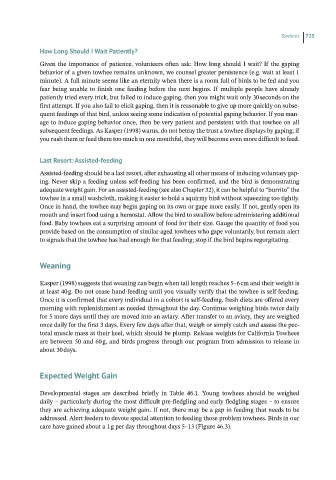Page 723 - Hand rearing birds second
P. 723
Towhees 725
How Long Should I Wait Patiently?
Given the importance of patience, volunteers often ask: How long should I wait? If the gaping
behavior of a given towhee remains unknown, we counsel greater persistence (e.g. wait at least 1
minute). A full minute seems like an eternity when there is a room full of birds to be fed and you
fear being unable to finish one feeding before the next begins. If multiple people have already
patiently tried every trick, but failed to induce gaping, then you might wait only 30 seconds on the
first attempt. If you also fail to elicit gaping, then it is reasonable to give up more quickly on subse-
quent feedings of that bird, unless seeing some indication of potential gaping behavior. If you man-
age to induce gaping behavior once, then be very patient and persistent with that towhee on all
subsequent feedings. As Kasper (1998) warns, do not betray the trust a towhee displays by gaping; if
you rush them or feed them too much in one mouthful, they will become even more difficult to feed.
Last Resort: Assisted-feeding
Assisted‐feeding should be a last resort, after exhausting all other means of inducing voluntary gap-
ing. Never skip a feeding unless self‐feeding has been confirmed, and the bird is demonstrating
adequate weight gain. For an assisted‐feeding (see also Chapter 32), it can be helpful to “burrito” the
towhee in a small washcloth, making it easier to hold a squirmy bird without squeezing too tightly.
Once in hand, the towhee may begin gaping on its own or gape more easily. If not, gently open its
mouth and insert food using a hemostat. Allow the bird to swallow before administering additional
food. Baby towhees eat a surprising amount of food for their size. Gauge the quantity of food you
provide based on the consumption of similar‐aged towhees who gape voluntarily, but remain alert
to signals that the towhee has had enough for that feeding; stop if the bird begins regurgitating.
Weaning
Kasper (1998) suggests that weaning can begin when tail length reaches 5–6 cm and their weight is
at least 40 g. Do not cease hand‐feeding until you visually verify that the towhee is self‐feeding.
Once it is confirmed that every individual in a cohort is self‐feeding, fresh diets are offered every
morning with replenishment as needed throughout the day. Continue weighing birds twice daily
for 5 more days until they are moved into an aviary. After transfer to an aviary, they are weighed
once daily for the first 3 days. Every few days after that, weigh or simply catch and assess the pec-
toral muscle mass at their keel, which should be plump. Release weights for California Towhees
are between 50 and 60 g, and birds progress through our program from admission to release in
about 30 days.
Expected Weight Gain
Developmental stages are described briefly in Table 46.1. Young towhees should be weighed
daily – particularly during the most difficult pre‐fledgling and early fledgling stages – to ensure
they are achieving adequate weight gain. If not, there may be a gap in feeding that needs to be
addressed. Alert feeders to devote special attention to feeding those problem towhees. Birds in our
care have gained about a 1 g per day throughout days 5–13 (Figure 46.3).

